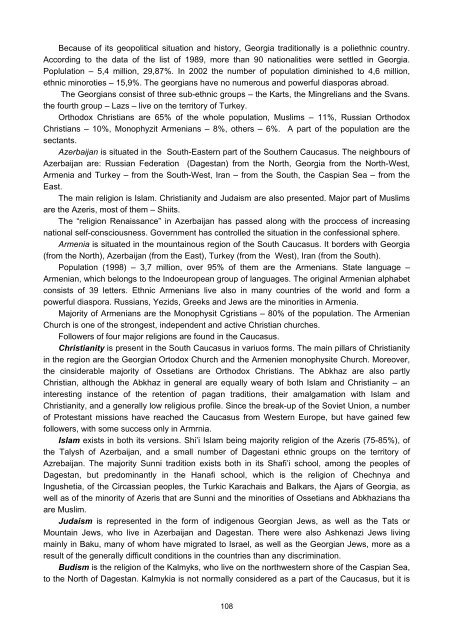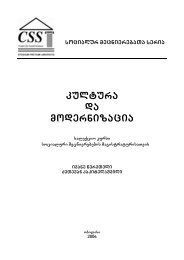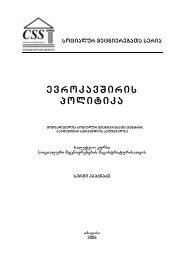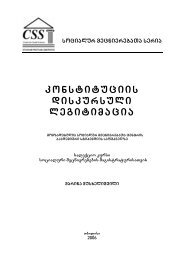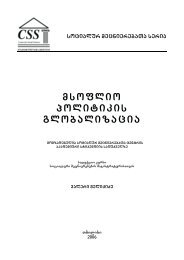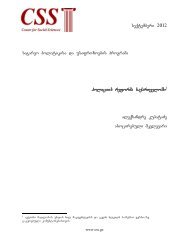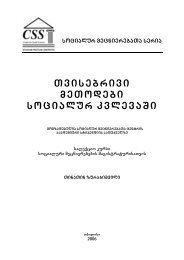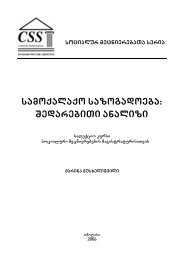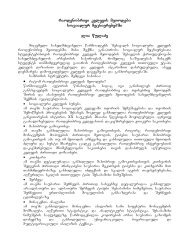kavkasiis geografiuli garemo da mosaxleoba - Center for Social ...
kavkasiis geografiuli garemo da mosaxleoba - Center for Social ...
kavkasiis geografiuli garemo da mosaxleoba - Center for Social ...
You also want an ePaper? Increase the reach of your titles
YUMPU automatically turns print PDFs into web optimized ePapers that Google loves.
Because of its geopolitical situation and history, Georgia traditionally is a poliethnic country.<br />
According to the <strong>da</strong>ta of the list of 1989, more than 90 nationalities were settled in Georgia.<br />
Poplulation – 5,4 million, 29,87%. In 2002 the number of population diminished to 4,6 million,<br />
ethnic minoroties – 15,9%. The georgians have no numerous and powerful diasporas abroad.<br />
The Georgians consist of three sub-ethnic groups – the Karts, the Mingrelians and the Svans.<br />
the fourth group – Lazs – live on the territory of Turkey.<br />
Orthodox Christians are 65% of the whole population, Muslims – 11%, Russian Orthodox<br />
Christians – 10%, Monophyzit Armenians – 8%, others – 6%. A part of the population are the<br />
sectants.<br />
Azerbaijan is situated in the South-Eastern part of the Southern Caucasus. The neighbours of<br />
Azerbaijan are: Russian Federation (Dagestan) from the North, Georgia from the North-West,<br />
Armenia and Turkey – from the South-West, Iran – from the South, the Caspian Sea – from the<br />
East.<br />
The main religion is Islam. Christianity and Ju<strong>da</strong>ism are also presented. Major part of Muslims<br />
are the Azeris, most of them – Shiits.<br />
The “religion Renaissance” in Azerbaijan has passed along with the proccess of increasing<br />
national self-consciousness. Government has controlled the situation in the confessional sphere.<br />
Armenia is situated in the mountainous region of the South Caucasus. It borders with Georgia<br />
(from the North), Azerbaijan (from the East), Turkey (from the West), Iran (from the South).<br />
Population (1998) – 3,7 million, over 95% of them are the Armenians. State language –<br />
Armenian, which belongs to the Indoeuropean group of languages. The original Armenian alphabet<br />
consists of 39 letters. Ethnic Armenians live also in many countries of the world and <strong>for</strong>m a<br />
powerful diaspora. Russians, Yezids, Greeks and Jews are the minorities in Armenia.<br />
Majority of Armenians are the Monophysit Cgristians – 80% of the population. The Armenian<br />
Church is one of the strongest, independent and active Christian churches.<br />
Followers of four major religions are found in the Caucasus.<br />
Christianity is present in the South Caucasus in variuos <strong>for</strong>ms. The main pillars of Christianity<br />
in the region are the Georgian Ortodox Church and the Armenien monophysite Church. Moreover,<br />
the cinsiderable majority of Ossetians are Orthodox Christians. The Abkhaz are also partly<br />
Christian, although the Abkhaz in general are equally weary of both Islam and Christianity – an<br />
interesting instance of the retention of pagan traditions, their amalgamation with Islam and<br />
Christianity, and a generally low religious profile. Since the break-up of the Soviet Union, a number<br />
of Protestant missions have reached the Caucasus from Western Europe, but have gained few<br />
followers, with some success only in Armrnia.<br />
Islam exists in both its versions. Shi’i Islam being majority religion of the Azeris (75-85%), of<br />
the Talysh of Azerbaijan, and a small number of Dagestani ethnic groups on the territory of<br />
Azrebaijan. The majority Sunni tradition exists both in its Shafi’i school, among the peoples of<br />
Dagestan, but predominantly in the Hanafi school, which is the religion of Chechnya and<br />
Ingushetia, of the Circassian peoples, the Turkic Karachais and Balkars, the Ajars of Georgia, as<br />
well as of the minority of Azeris that are Sunni and the minorities of Ossetians and Abkhazians tha<br />
are Muslim.<br />
Ju<strong>da</strong>ism is represented in the <strong>for</strong>m of indigenous Georgian Jews, as well as the Tats or<br />
Mountain Jews, who live in Azerbaijan and Dagestan. There were also Ashkenazi Jews living<br />
mainly in Baku, many of whom have migrated to Israel, as well as the Georgian Jews, more as a<br />
result of the generally difficult conditions in the countries than any discrimination.<br />
Budism is the religion of the Kalmyks, who live on the northwestern shore of the Caspian Sea,<br />
to the North of Dagestan. Kalmykia is not normally considered as a part of the Caucasus, but it is<br />
108


